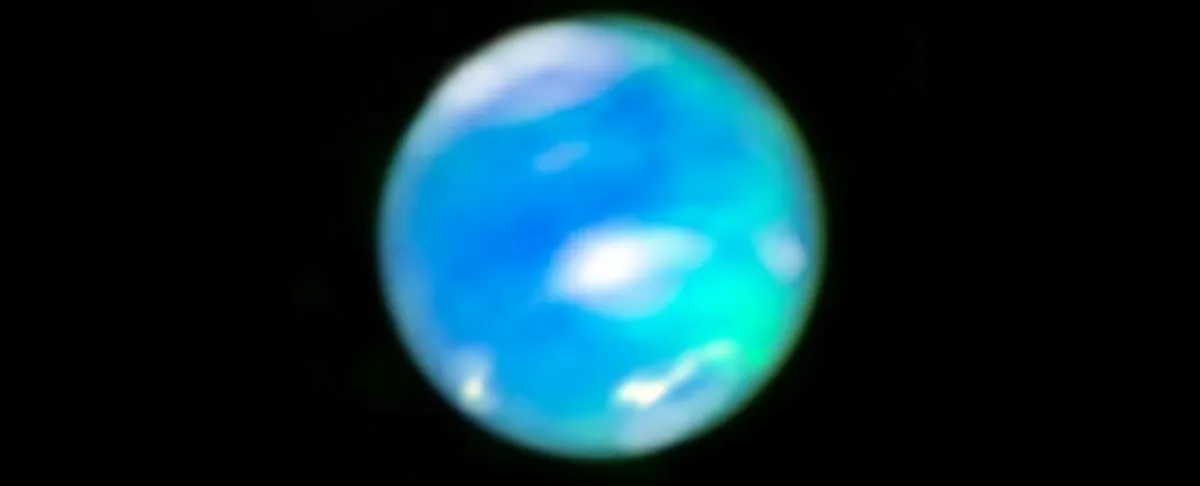
The most elusive planetary aurora in the Solar System has finally been revealed in all its gently glowing glory. Far from the Sun and Earth, the sky-blue planet Neptune has been captured shimmering in near-infrared light as particles interact within its hazy atmosphere. This marks the first time an aurora has been imaged on the Solar System's outermost known planet, thanks to the sensitivity of the James Webb Space Telescope (JWST)'s powerful near-infrared spectrometer. At last, the set is complete, as auroras have been seen on every planet in the Solar System.
The phenomenon of auroras is not only widespread but also reveals the intricate interactions between planets and the Sun. However, the appearance and characteristics of these auroras can vastly differ depending on the planet. Earth's auroras are known for their spectacular displays, showcasing a panoply of colors that light up the night sky when particles from the solar wind collide with Earth's magnetic field. This interaction causes the resident particles in the atmosphere to create dancing, glowing lights.
On the other hand, Jupiter hosts the most powerful and energetic auroras in the Solar System, featuring permanent caps of bright ultraviolet light. Interestingly, its four largest moons also exhibit auroras. Similarly, Saturn and Mars display ultraviolet auroras, while Venus showcases green auroras akin to those observed on Earth. Meanwhile, Mercury presents a unique case; due to its lack of atmosphere, its auroras manifest as X-ray fluorescence resulting from the interaction between solar particles and surface minerals.
For a long time, scientists were uncertain about the presence of auroral activity on Uranus and Neptune, given their distance from the Sun. Uranus orbits at approximately 19 times the distance between the Sun and Earth, while Neptune is even farther at around 30 times this distance. In 2023, an analysis of archival data confirmed the presence of infrared auroras at the equator of Uranus. Now, thanks to the data from JWST, the existence of similar auroras at Neptune has been confirmed.
In 2023, the JWST obtained a detailed spectrum of Neptune's atmosphere, revealing a clear presence of the trihydrogen cation (H3+). This positively charged form of trihydrogen is closely associated with auroras. By tracking the concentration of H3+ across Neptune's skies, a team of astronomers led by Henrik Melin from Northumbria University in the UK was able to map the locations of the planet's auroras.
Interestingly, a quirk of Neptune's magnetic field means that its auroras are not located where they would typically appear on Earth. Unlike Earth's magnetic field, which converges around the poles, Neptune's magnetic field is lopsided and messy. This results in the solar particles being funneled near the planet's equator, rather than at the poles. This unique configuration has made it challenging to detect auroras on Neptune until now.
Measurements of Neptune's temperature taken by JWST revealed why detecting the planet's auroras has been so difficult. Previous measurements from Voyager 2 indicated much higher temperatures compared to those observed by JWST, suggesting that Neptune has cooled significantly since 1989. Colder temperatures result in fainter auroras, and earlier predictions about Neptune's auroras were based on inaccurate thermal data, causing scientists to seek the wrong indicators.
This groundbreaking discovery provides researchers with a new tool to interpret the variety of auroras across different celestial bodies, including those orbiting alien stars. Given that the most commonly detected type of extrasolar planet is Neptune-sized, and considering Neptune's lack of extreme seasons compared to Uranus, the researchers assert that these observations are crucial for probing atmosphere-magnetosphere interactions on the most common-sized worlds in our galaxy.